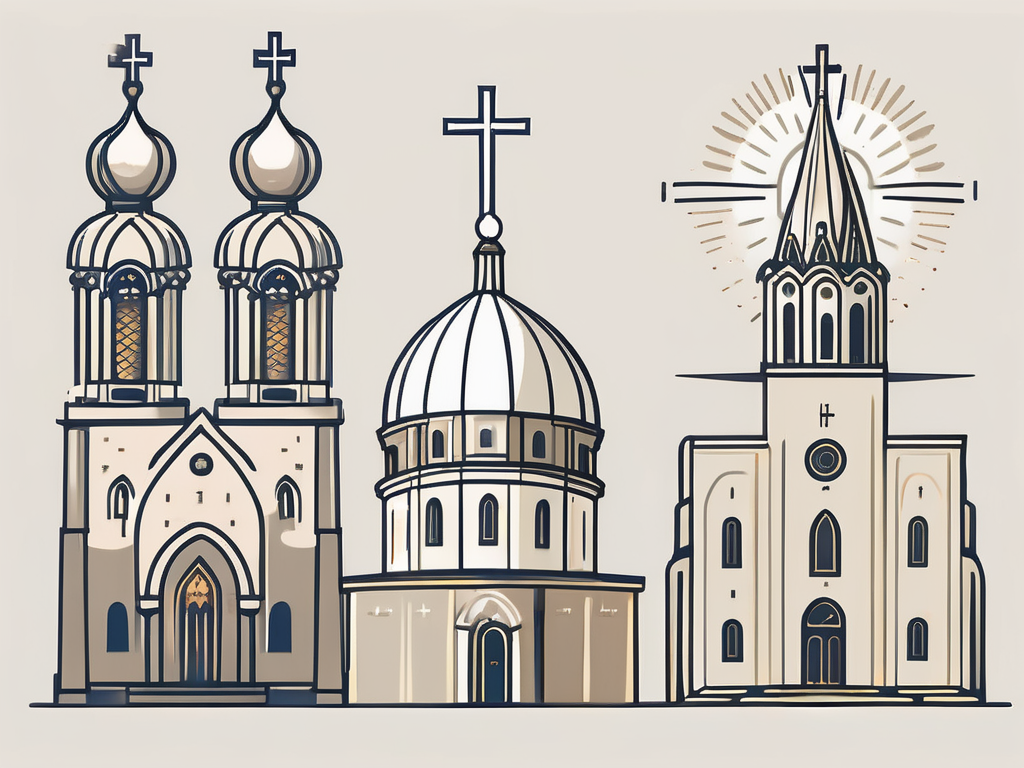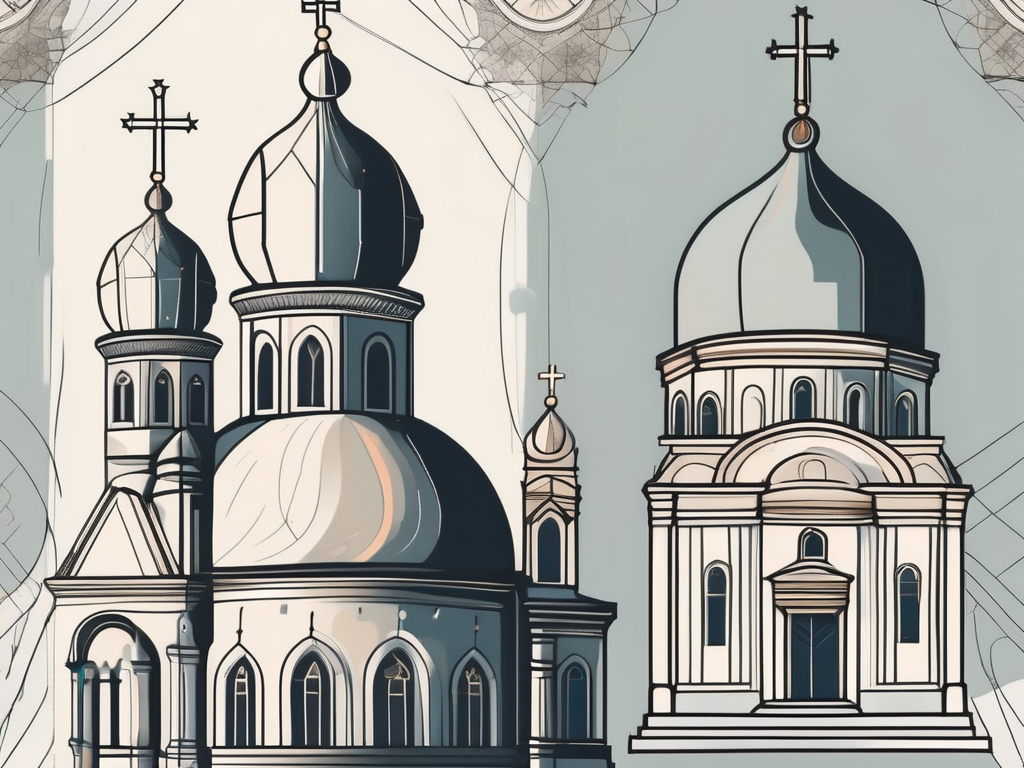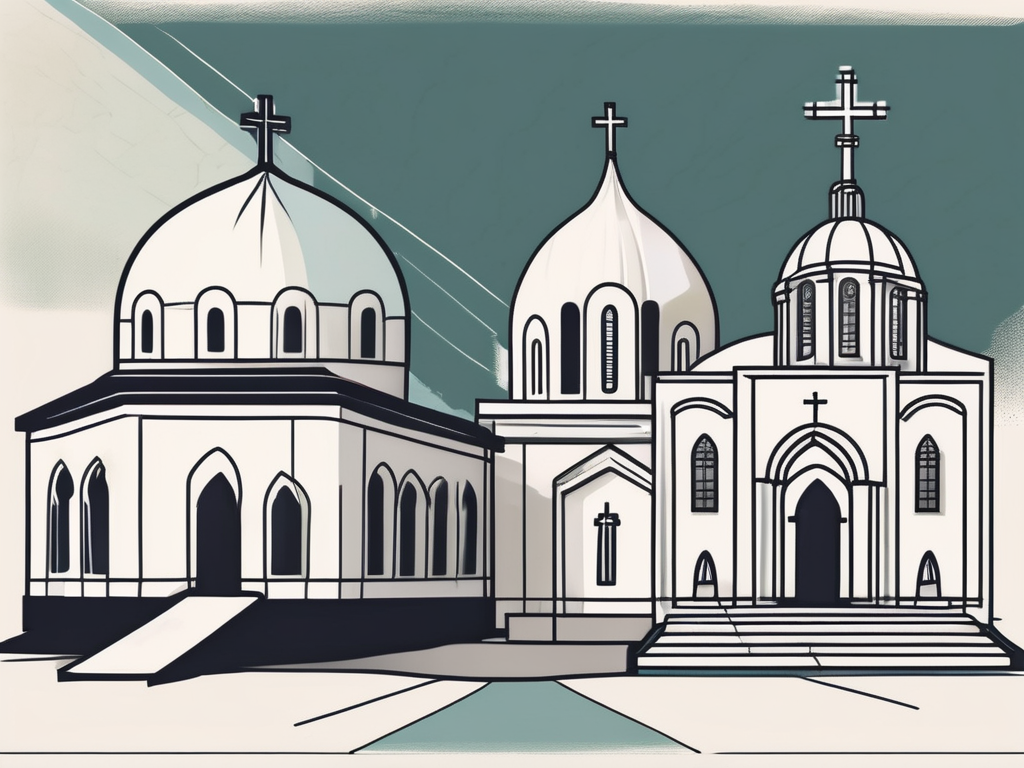In the world of Christianity, there are many different denominations with their own unique beliefs and practices. Two such denominations that often draw comparisons are the Eastern Orthodox Church and the Lutheran Church. While both share a common foundation in Christian teachings, they have distinct differences that set them apart. In this article, we will delve into the historical background, core beliefs and doctrines, liturgical practices, theological differences, and the role of clergy and laity in the Eastern Orthodox and Lutheran churches.
Historical Background of Eastern Orthodox and Lutheran Churches
The Eastern Orthodox Church has its roots in the early Christian Church. It traces its origin back to the time of Jesus Christ and the Apostles. Throughout history, it has had a significant presence in countries like Greece, Russia, and Eastern Europe. The Eastern Orthodox Church is known for its rich liturgical traditions, iconography, and emphasis on the mystical experience of God.
One of the defining moments in the history of the Eastern Orthodox Church was the Great Schism of 1054, which led to the permanent division between the Eastern Orthodox Church and the Roman Catholic Church. This split was primarily due to disagreements over theological and ecclesiastical issues, such as the authority of the Pope and the use of unleavened bread in the Eucharist.
The Eastern Orthodox Church has played a crucial role in the preservation of Christian theology and spirituality throughout the centuries. Its monastic tradition, with its focus on prayer, asceticism, and contemplation, has produced numerous influential theologians and mystics. The writings of figures like St. John Chrysostom, St. Basil the Great, and St. Gregory Palamas continue to be studied and revered by Orthodox Christians.
The Lutheran Church, on the other hand, was founded in the 16th century during the Protestant Reformation by Martin Luther in Germany. Luther, a Catholic monk and theologian, became disillusioned with certain practices and teachings of the Roman Catholic Church, particularly the sale of indulgences. He believed that salvation was a gift of God’s grace, received through faith in Jesus Christ, and not something that could be earned through good works or purchased.
Luther’s Ninety-Five Theses, which he famously nailed to the door of the Castle Church in Wittenberg in 1517, sparked a widespread movement for reform within the Church. This movement, known as Lutheranism, spread rapidly across Europe and challenged the authority of the Roman Catholic Church. Luther’s teachings emphasized the importance of the Bible as the ultimate authority in matters of faith and the priesthood of all believers.
Despite their different historical origins, both the Eastern Orthodox Church and the Lutheran Church have had a profound impact on the development of Christianity and continue to thrive today. The Eastern Orthodox Church, with its ancient traditions and mystical spirituality, has preserved the teachings and practices of the early Church. The Lutheran Church, with its emphasis on the primacy of Scripture and justification by faith, has shaped the theological landscape of Protestant Christianity.
Today, the Eastern Orthodox Church remains a vibrant and influential religious tradition, with millions of adherents around the world. Its liturgical worship, sacramental theology, and emphasis on theosis (the process of becoming one with God) continue to inspire and guide Orthodox Christians in their spiritual journey.
The Lutheran Church, too, has spread to various parts of the world and has diversified into different denominations and synods. Lutheranism has had a significant impact on the development of Protestant Christianity, influencing the theology, worship, and social ethics of many Protestant churches.
In conclusion, the historical background of the Eastern Orthodox and Lutheran Churches reveals their unique origins, theological distinctives, and contributions to the wider Christian tradition. Both churches have played vital roles in shaping the course of Christianity and continue to be influential forces in the religious landscape of the world.
Core Beliefs and Doctrines
Understanding the core beliefs and doctrines of these two denominations is essential in grasping their differences. The Eastern Orthodox Church places great emphasis on tradition and the preservation of apostolic teachings. It believes in the infallibility of Scripture and the importance of the sacraments in the journey of salvation. The Lutheran Church, on the other hand, upholds the Bible as the ultimate authority in matters of faith and practice. It holds that salvation is solely a result of God’s grace and is received through faith alone in Jesus Christ.
When delving deeper into the core beliefs and doctrines of these two denominations, it becomes evident that their theological perspectives shape their understanding of salvation and the role of the Holy Trinity.
The Eastern Orthodox Church, with its rich history and deep reverence for tradition, places a strong emphasis on the preservation of apostolic teachings. It believes that the Holy Spirit guides the Church, ensuring the accuracy and authority of its teachings. The infallibility of Scripture is a fundamental belief, as it is seen as the inspired Word of God. The sacraments, such as baptism and the Eucharist, are considered essential in the journey of salvation. Through these sacraments, believers are united with Christ and receive His grace, which is necessary for salvation.
On the other hand, the Lutheran Church, influenced by the teachings of Martin Luther, emphasizes the authority of the Bible as the ultimate source of truth. It believes that salvation is solely a result of God’s grace, which is freely given to humanity. This grace is received through faith alone in Jesus Christ, without the need for any additional works or sacraments. Lutherans believe that the sacraments, such as baptism and the Lord’s Supper, are important acts of obedience and expressions of faith, but they do not play a role in the actual process of salvation.
Both denominations share a belief in the Holy Trinity, affirming the existence of one God in three persons: Father, Son, and Holy Spirit. However, their understanding of the nature of salvation and the way it is received diverges. The Eastern Orthodox Church sees salvation as a transformative journey, where believers participate in the life of Christ through the sacraments and the guidance of the Church. In contrast, the Lutheran Church emphasizes salvation as a gift of God’s grace, received through faith in Jesus Christ alone.
By examining the core beliefs and doctrines of these two denominations, it becomes clear that their theological perspectives shape their understanding of salvation and the role of the Holy Trinity. While both hold a deep reverence for Scripture, the Eastern Orthodox Church places a greater emphasis on tradition and the sacraments, while the Lutheran Church emphasizes the authority of the Bible and salvation by grace through faith alone. These differences in belief and practice contribute to the distinctiveness of each denomination and their theological perspectives.
Liturgical Practices and Traditions
The worship styles and liturgical traditions of the Eastern Orthodox and Lutheran Churches manifest their distinct cultural influences and historical practices. The Eastern Orthodox Church practices a rich and deeply symbolic form of worship, characterized by elaborate rituals, iconography, and choral chants. The liturgical traditions emphasize the mystical connection between the worshiper and the divine.
In the Eastern Orthodox Church, the liturgy is a sacred and transformative experience. Every aspect of the service is carefully choreographed to create a sense of awe and reverence. The use of incense, candles, and the presence of icons all contribute to the sensory richness of the worship space. The chants and hymns, sung in ancient languages such as Greek or Slavonic, transport the worshipers to a different time and place, connecting them to the long history of their faith.
One of the most striking features of Eastern Orthodox worship is the veneration of icons. Icons are not mere religious art but are believed to be windows into the divine realm. They are seen as a means of encountering the presence of God and the saints. During the liturgy, the faithful approach the icons, kiss them, and offer prayers. This physical interaction with the icons deepens the spiritual connection between the worshiper and the divine.
On the other hand, the Lutheran Church has a more simplified approach to worship. It focuses on preaching the Word of God and the administration of the sacraments. While still incorporating elements of ritual and hymnody, Lutheran services tend to prioritize the spoken word and congregational participation.
In a typical Lutheran service, the sermon plays a central role. The pastor delivers a carefully prepared message, expounding on the biblical text and offering guidance and encouragement to the congregation. The sermon is seen as a means of teaching and inspiring the faithful, helping them to apply the teachings of the Bible to their daily lives.
Another important aspect of Lutheran worship is the administration of the sacraments, particularly baptism and the Eucharist. Baptism is seen as a rite of initiation into the Christian faith, symbolizing the washing away of sin and the new birth in Christ. The Eucharist, or Holy Communion, is a sacred meal where the faithful partake of bread and wine, believing that they are receiving the body and blood of Christ.
While the Lutheran liturgy may not be as visually elaborate as that of the Eastern Orthodox Church, it still incorporates elements of ritual and hymnody. Hymns, sung by the congregation, are an integral part of Lutheran worship. These hymns, often rich in theological content, serve as a means of expressing praise, thanksgiving, and devotion to God.
Overall, both the Eastern Orthodox and Lutheran Churches have distinct liturgical practices and traditions that reflect their historical and cultural contexts. Whether through the elaborate rituals and iconography of the Eastern Orthodox Church or the emphasis on preaching and sacraments in the Lutheran Church, both traditions seek to create a space for worship that fosters a deep connection between the worshiper and the divine.
Theological Differences and Similarities
One of the key theological differences between the Eastern Orthodox and Lutheran Churches lies in their views on salvation. The Eastern Orthodox Church teaches that salvation is a lifelong process of theosis, or the transformation of believers into the likeness of God, achieved through participation in the sacraments and the cooperation of the individual with God’s grace. This concept of theosis finds its roots in the early church fathers, particularly in the teachings of St. Athanasius and St. Gregory of Nyssa. The Eastern Orthodox Church believes that salvation is not a one-time event but a continuous journey of spiritual growth and union with God.
On the other hand, the Lutheran Church emphasizes salvation by grace alone, received through faith in Jesus Christ. This doctrine of justification by faith alone, known as sola fide, was a central tenet of the Protestant Reformation led by Martin Luther in the 16th century. Lutherans believe that salvation is a free gift from God, not earned through good works or cooperation with divine grace. They view good works as a natural outflow of faith, but not as a means of attaining salvation.
Despite these differences in the understanding of salvation, both the Eastern Orthodox and Lutheran Churches share a common belief in the centrality of Jesus Christ as the savior of humanity. Both traditions affirm the divinity and humanity of Christ and acknowledge His sacrificial death and resurrection as the means of redemption for all people.
Another area of theological divergence is the understanding of sacraments. The Eastern Orthodox Church recognizes seven sacraments: Baptism, Chrismation, Eucharist, Confession, Holy Unction, Holy Matrimony, and Holy Orders. These sacraments are seen as visible signs of God’s invisible grace, through which believers are united with Christ and receive His sanctifying power.
On the other hand, the Lutheran Church recognizes two sacraments: Baptism and the Lord’s Supper (also known as Holy Communion or the Eucharist). Lutherans believe that these sacraments were instituted by Christ Himself and are means of grace through which God’s forgiveness and presence are conveyed to the recipients. While Lutherans do not consider the other five sacraments as sacraments in the same sense, they still value practices such as confession and marriage as important aspects of the Christian life.
Despite these differences, both traditions regard the sacraments as profound encounters with God and important means of receiving His grace. Both the Eastern Orthodox and Lutheran Churches believe that the sacraments are not merely symbolic rituals but effective channels of divine grace, through which believers are united with Christ and nourished in their spiritual journey.
Role of Clergy and Laity
The role of clergy and laity in the Eastern Orthodox and Lutheran Churches highlights another distinction between the two traditions. In the Eastern Orthodox Church, the clergy play a central role in leading the congregation and administering the sacraments. They are considered the intermediaries between God and the people. The laity, while actively participating in worship, often defer to the guidance of the clergy.
Contrastingly, the Lutheran Church places a strong emphasis on the priesthood of all believers. It empowers the laity to actively engage in worship, education, and outreach. While the clergy maintain important roles in leading and guiding the congregation, the participation and contributions of the laity are highly valued.
Conclusion
Although the Eastern Orthodox and Lutheran Churches share a common faith in Jesus Christ, their historical backgrounds, core beliefs and doctrines, liturgical practices, theological perspectives, and the roles of clergy and laity set them apart. Understanding these key differences allows us to appreciate the diversity within the broader Christian tradition and fosters a deeper understanding among believers of different denominations. Whether one identifies as Eastern Orthodox or Lutheran, the pursuit of faith and the commitment to living out the teachings of Christ remain at the heart of both traditions.












